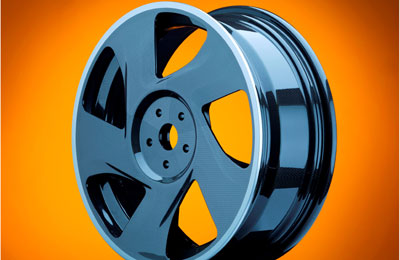
The thermoplastic carbon composite wheel
Sabic developing thermoplastic carbon composite wheel
Riyadh, June 4, 2014
Saudi Basic Industries Corporation (Sabic), Kringlan Composites, and other industry partners are working to further advance the development of the world’s first thermoplastic composite wheel, it has been revealed.
To advance the wheel’s development, Sabic and Kringlan have been working on a prototype for a German automotive manufacturer. This innovative and lightweight wheel – the first of its kind in the world – is strong, light, stunning in design. The significant weight savings made possible through Kringlan’s revolutionary wheel design, coupled with the ground-breaking material technology employed, can improve fuel economy. The concept also offers a more sustainable solution. Not only can emissions associated with the vehicle’s use phase be reduced, but the wheel can be manufactured with less environmental impact compared to conventional processes and it offers full system recyclability, said a Sabic statement.
The design of the part also provides the flexibility for the wheel to be mounted with traditional metal spokes, or spokes with carbon fiber-reinforced Ultem resin composites, potentially enabling even greater weight savings, it said.
This ground breaking innovation leverages Sabic’s proprietary Ultem resin and Kringlan’s proprietary three-dimensional composite design capabilities to create a material solution that can be used to replace traditional materials, such as metal and aluminum alloy, helping reduce weight and emissions, and potentially save manufacturing costs across industries from aerospace to automotive, and consumer goods, Ernesto Occhiello, Sabic executive vice president, technology and innovation, said.
Thierry Materne, vice president, technology & innovation for Sabic’s Innovative Plastics business, said: “This ongoing collaboration with Kringlan is an excellent example of how we identify innovative companies with unique technology to collaborate on developing industry breakthrough for the benefit of the downstream industries that we serve.”
He added: “Combining Sabic’s high-performance Ultem resin with Kringlan’s proprietary three-dimensional manufacturing technology for carbon composites offers OEMs the opportunity for reduced weight, lower production costs, as well as material recyclability. When compared to other thermoplastic materials, the Ultem resin composite concept offers superior strength at high temperatures, dimensional stability as well as resistance to chemicals.”
The full composite wheel prototype complies with current standards set for metal wheels by the German testing institute TüV, enhancing the opportunity to work with additional global automotive OEMs for the prototyping of lightweight wheels according to their specific design and specifications.
“This new material technology resulting from the ongoing collaboration between Kringlan and Sabic has the potential to be a breakthrough for OEMs in multiple industries,” said Steffen Heinecke, CEO of Kringlan. “Sabic’s support is critical to the success of this project. In addition to their world-class material technology, they provide application and secondary operation expertise. Already, in the automotive industry alone, several OEMs have shown interest in the carbon composite wheel application, which can enable the reduction of CO2 from a passenger car by two to three percent.”
While the first application of this new technology is being driven in the automotive industry, its potential reach extends to multiple industries where weight reduction is a key driver.
To illustrate this, in consumer appliances, OEMs are focused on designing their products to achieve energy efficiency certifications. With this carbon fiber composite using Ultem resin, appliance OEMs can replace metal with a lighter and equally strong technology, which can help to reduce the amount of energy used during operation and contribute to the energy efficiency performance required for certification, the statement said.
In washing machines, for example, this new three-dimensional carbon fiber composite technology can reduce the inertia – the amount of energy needed – to start the machine drum moving, compared to current metal alternatives, which can mean greater efficiency, and potentially a lower carbon footprint for the machine. Additionally, by considering the use of the ULTEM resin-based carbon fiber composites with Kringlan’s manufacturing technology, appliance manufacturers can potentially save costs by reducing the number of secondary operations required to develop key parts.
“We are very excited about our on-going collaborative work with Kringlan,” added Materne. “We share with them a passion to constantly drive innovation in thermoplastic applications. Our work with Kringlan demonstrates how we constantly strive to deliver added value, drawing upon our deep and relevant portfolio of material technologies, our in-depth expertise in materials science and engineering and the strong understanding that we have of our customers’ challenges and requirements. It is this know-how in materials and applications combined with our collaborative approach that allows us to fulfil Sabic’s promise to deliver chemistry that matters.” - TradeArabia News Service







